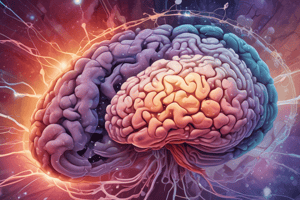Podcast
Questions and Answers
What is a characteristic feature of Glioblastoma Multiforme?
What is a characteristic feature of Glioblastoma Multiforme?
- It is typically benign in nature
- It rarely infiltrates brain tissue
- It is commonly seen in the first decade of life
- It produces a bilateral lesion by crossing the corpus callosum (correct)
What is the most common cause of severe skull injuries?
What is the most common cause of severe skull injuries?
- Work-related injuries
- Motor vehicular accidents, particularly among the young (correct)
- Sport-related accidents
- Falls, especially in those below 15 and above 65 years of age
What is a factor that determines the magnitude of a cranial injury?
What is a factor that determines the magnitude of a cranial injury?
- The type of brain tumor present
- The location of the injury on the skull
- The age of the individual at the time of injury
- The shape of the object causing the trauma (correct)
What is the significance of the anatomic location of the lesion in CNS trauma?
What is the significance of the anatomic location of the lesion in CNS trauma?
What is the typical prognosis of Glioblastoma Multiforme?
What is the typical prognosis of Glioblastoma Multiforme?
What is the significance of the force of the impact in cranial injuries?
What is the significance of the force of the impact in cranial injuries?
In which age groups are falls a common cause of cranial injuries?
In which age groups are falls a common cause of cranial injuries?
What is a characteristic of Astrocytomas?
What is a characteristic of Astrocytomas?
What is the significance of necrosis of brain parenchyma in the frontal lobe?
What is the significance of necrosis of brain parenchyma in the frontal lobe?
Why is the head in motion at the time of injury a significant factor in cranial trauma?
Why is the head in motion at the time of injury a significant factor in cranial trauma?
Flashcards are hidden until you start studying
Study Notes
CNS Tumors
- Symptoms of intracranial tumors include involuntary release of functional areas, space-occupying effect, and increased intracranial pressure, leading to headaches and vomiting.
- Primary neoplasm includes astrocytomas, which account for 20-30% of glioma group tumors.
Astrocytomas
- These tumors are histologically benign and susceptible to malignant transformation after a variable time interval.
- Sites of occurrence include cerebral hemispheres in adults, optic nerve, walls of third ventricle, midbrain, pons, and cerebellum in the first two decades of life, and spinal cord predominantly in the thoracic and cervical regions.
- Morphology:
- Gross: poorly demarcated tumor with an indistinct margin.
- Microscopic: several morphological variants, including fibrillary astrocytoma and gemistocytic astrocytoma.
- Prognosis: life expectancy is approximately 5 years, with transformation to glioblastoma multiforme in 10% of cases, reducing life expectancy.
Glioblastoma Multiforme
- Characterized by marked pleomorphism, deep hemispheric tumor, and regional zones of necrosis.
- Accounts for 40% of all intracranial tumors.
- Prognosis: rarely exceeds 18 months in its clinical course, typically seen in the later decades of life.
Classification of CNS Tumors
- Topography:
- Infratentorial: midline tumors, including fourth ventricle tumors, cerebellar tumors, and brainstem tumors.
- Extraparenchymatous: e.g., cerebellopontine angle tumors.
- Intraspinal tumors:
- Extradural: originating from the spine or within the spinal canal.
- Intradural: subdural, extramedullary, or intramedullary.
- Histology:
- Classified according to the histological elements from which they are derived.
- Neuroectoderm: gliomas.
- Mesenchymal structures: meningiomas.
- Ectopic tissues: craniopharyngiomas, dermoid, and epidermoid cysts.
Characteristics of CNS Tumors
- Age of the patient vs. location of the tumor:
- Astrocytoma: occurs predominantly in the cerebral hemispheres in middle life and old age, in the cerebellum and pons in childhood, and in the spinal cord in young adults.
- Ependymoma: highest incidence in the fourth ventricle in children, and in the spinal cord in adults.
- Benign vs. malignant:
- Destruction of functional neural tissue creates a neurological deficit, which may be sensory or motor.
- Frequent mitosis, regional zones of necrosis, and infiltration of surrounding tissue.
CranioCerebral Injuries
- Introduction:
- About 50% of severe skull injuries result from motor vehicular accidents, particularly among the young.
- Other causes include falls, sport-related accidents, and work-related injuries.
- Factors influencing the severity of CNS trauma:
- Anatomic location of the lesion.
- Limited capacity of the brain for functional repair.
- The magnitude and distribution of the injury depend on:
- Shape of the object causing the trauma.
- Force of the impact.
- Whether the head is in motion at the time of the injury.
Studying That Suits You
Use AI to generate personalized quizzes and flashcards to suit your learning preferences.




